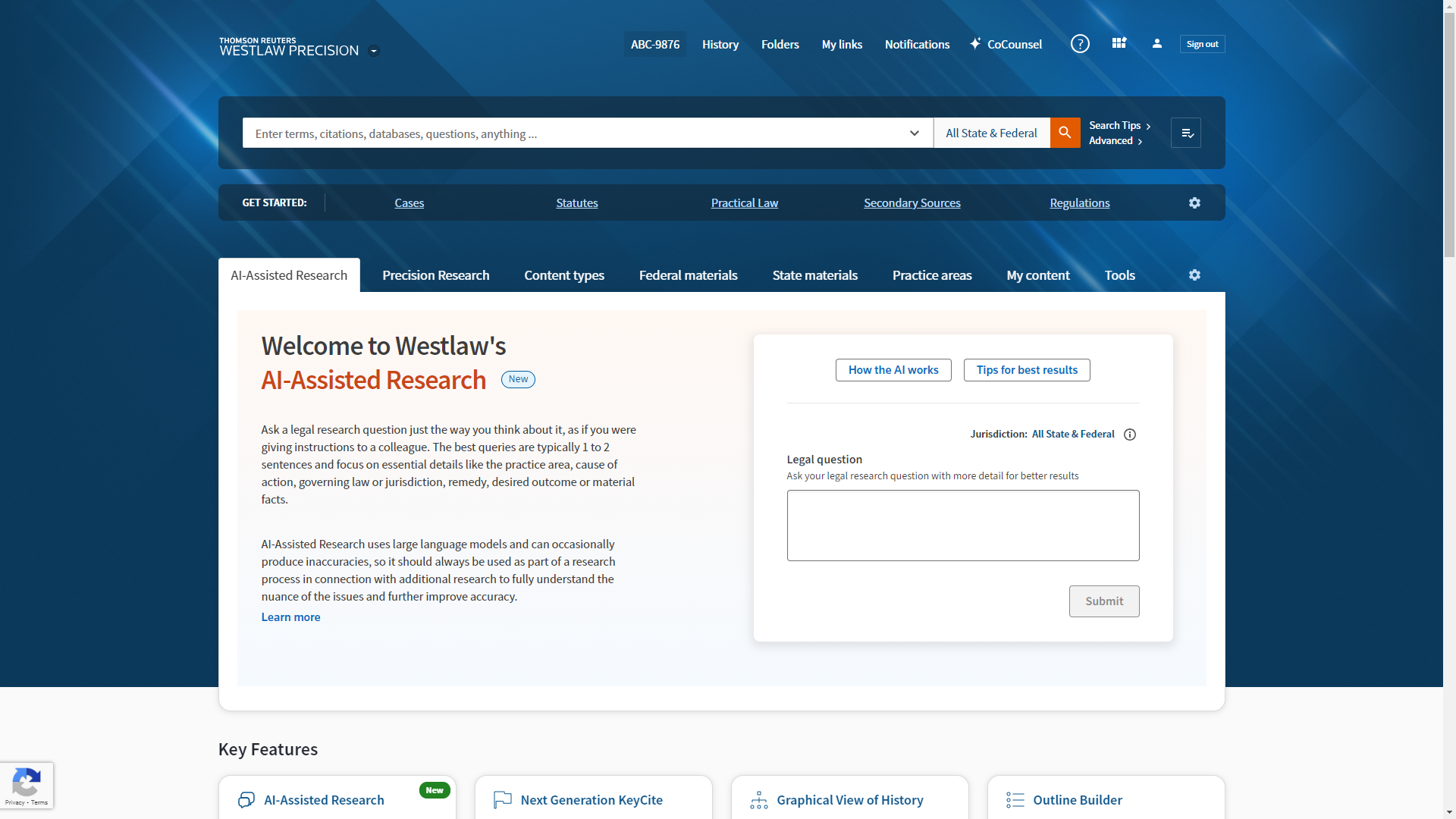
Westlaw AI-Assisted Research: Complete Buyer's Guide
Research acceleration platform for legal professionals
Westlaw AI-Assisted Research represents Thomson Reuters' strategic integration of conversational AI into the established Westlaw ecosystem, positioning itself as a research acceleration platform rather than a standalone AI solution. Built on Retrieval Augmented Generation (RAG) technology that searches Westlaw's comprehensive legal database before generating responses, the platform leverages Thomson Reuters' 150+ years of legal classification expertise and West Key Number System integration to differentiate from general-purpose AI tools[40][48][49][44].
Market Position & Maturity
Market Standing
Thomson Reuters occupies a dominant market position in legal information services with over 150 years of legal classification expertise and comprehensive content database integration, providing substantial competitive moats for AI-Assisted Research deployment[44][48].
Company Maturity
Market maturity indicators demonstrate enterprise-scale operations with comprehensive legal database coverage, established customer relationships, and proven technical infrastructure capable of supporting AI enhancement without disrupting core business operations[44][51].
Industry Recognition
Industry recognition patterns show mixed validation: Customer satisfaction evidence demonstrates research acceleration benefits among users implementing proper verification procedures[52][54]. However, independent academic evaluation revealing 33% hallucination rates compared to 17% for LexisNexis creates reputational risks that may affect market positioning[56].
Strategic Partnerships
Strategic partnerships and ecosystem integration strengthen market position through Microsoft Azure deployment capabilities and established legal software compatibility, enabling enterprise-scale deployment without requiring separate infrastructure investment[40].
Longevity Assessment
Long-term viability assessment indicates strong foundation based on Thomson Reuters' financial stability, established customer base, and comprehensive legal content assets that support continued AI development investment[44][48].
Proof of Capabilities
Customer Evidence
Customer evidence demonstrates measurable research acceleration across diverse practice areas and firm sizes. Guy D'Andrea at Laffey Bucci D'Andrea Reich & Ryan implements systematic quality control through parallel prompting of law clerks and AI systems, documenting identical case information delivery in minutes versus days when given the same research prompts[54].
Quantified Outcomes
Thomson Reuters customer survey data validates performance claims with 101 attorneys reporting users found relevant cases "over 2x as fast" compared to traditional research methods, with 97% reporting faster access to important cases and 90% finding cases they might not have otherwise discovered[50].
Case Study Analysis
Real-world deployment evidence spans multiple practice areas: Safa Riadh at Valiant Law documents using the platform during trial proceedings to resolve real-time legal questions, enabling immediate responses that guide judicial discretion decisions[53].
Market Validation
Enterprise customer adoption includes established law firms implementing AI-Assisted Research within existing Westlaw workflows, demonstrating market validation among professional legal practitioners[50][52][53][54].
Competitive Wins
Competitive validation emerges through customer retention and continued usage patterns, with customers emphasizing platform advantages including content comprehensiveness and source validation capabilities that differentiate from general-purpose AI tools[50].
AI Technology
Westlaw AI-Assisted Research employs sophisticated Retrieval Augmented Generation (RAG) architecture that searches Thomson Reuters' comprehensive legal database before generating conversational responses, grounding outputs in authoritative legal content rather than general internet sources[40][48][49].
Architecture
The platform's technical foundation integrates West Key Number System classifications, headnotes, and KeyCite analysis to enhance accuracy through structured legal taxonomy, processing current law continuously rather than relying on static training data[44][51].
Primary Competitors
Primary competitors include LexisNexis Lexis+ AI as the direct competitive alternative, with independent Stanford University evaluation showing Westlaw AI-Assisted Research hallucinates "at nearly twice the rate of the LexisNexis product" (33% vs 17%)[56].
Competitive Advantages
Competitive advantages center on integration with Thomson Reuters' comprehensive legal content ecosystem and established editorial enhancements, providing content depth that standalone AI tools cannot match[44][48].
Market Positioning
Market positioning emphasizes ecosystem integration and authoritative content connection rather than standalone AI capabilities, targeting existing Westlaw subscribers seeking research acceleration within established workflows[50][53].
Win/Loss Scenarios
Win/loss scenarios suggest Westlaw AI-Assisted Research excels for existing Westlaw subscribers with established verification procedures, particularly when content comprehensiveness and legal authority integration outweigh accuracy concerns[56].
Key Features

Pros & Cons
Use Cases
Integrations
Featured In Articles
Comprehensive analysis of AI Legal ChatGPT Fine-Tuning for Legal/Law Firm AI Tools for Legal/Law Firm AI Tools professionals. Expert evaluation of features, pricing, and implementation.
How We Researched This Guide
About This Guide: This comprehensive analysis is based on extensive competitive intelligence and real-world implementation data from leading AI vendors. StayModern updates this guide quarterly to reflect market developments and vendor performance changes.
58+ verified sources per analysis including official documentation, customer reviews, analyst reports, and industry publications.
- • Vendor documentation & whitepapers
- • Customer testimonials & case studies
- • Third-party analyst assessments
- • Industry benchmarking reports
Standardized assessment framework across 8 key dimensions for objective comparison.
- • Technology capabilities & architecture
- • Market position & customer evidence
- • Implementation experience & support
- • Pricing value & competitive position
Research is refreshed every 90 days to capture market changes and new vendor capabilities.
- • New product releases & features
- • Market positioning changes
- • Customer feedback integration
- • Competitive landscape shifts
Every claim is source-linked with direct citations to original materials for verification.
- • Clickable citation links
- • Original source attribution
- • Date stamps for currency
- • Quality score validation
Analysis follows systematic research protocols with consistent evaluation frameworks.
- • Standardized assessment criteria
- • Multi-source verification process
- • Consistent evaluation methodology
- • Quality assurance protocols
Buyer-focused analysis with transparent methodology and factual accuracy commitment.
- • Objective comparative analysis
- • Transparent research methodology
- • Factual accuracy commitment
- • Continuous quality improvement
Quality Commitment: If you find any inaccuracies in our analysis on this page, please contact us at research@staymodern.ai. We're committed to maintaining the highest standards of research integrity and will investigate and correct any issues promptly.